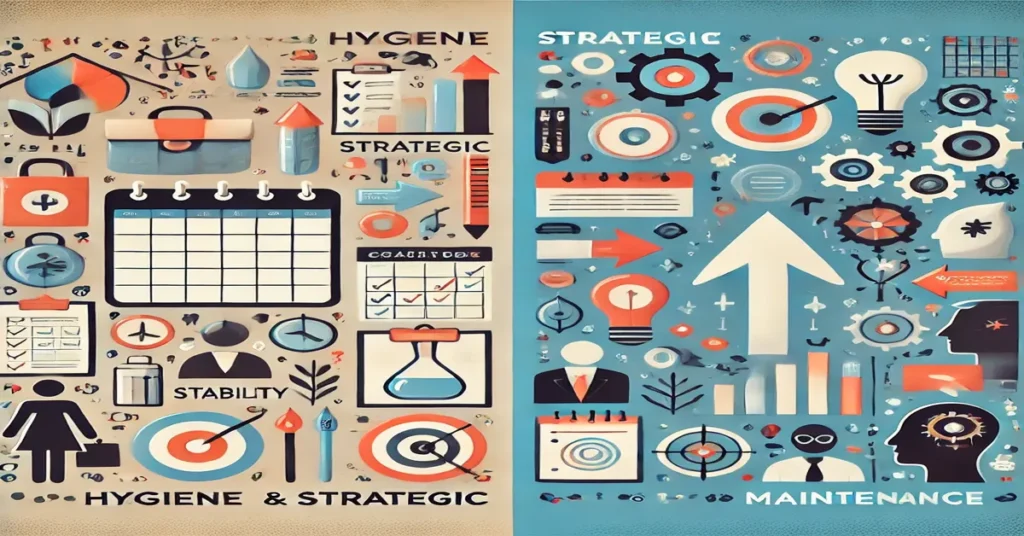In business, professional, and personal development, success often hinges on differentiating between tasks, behaviors, or choices that are fundamental “hygiene vs strategic” factors and those that are “strategic” in nature. The former involves maintaining a standard or avoiding negative outcomes, while the latter centers on setting directions and goals to achieve growth. By understanding and managing these distinctions, individuals and organizations can achieve balance, drive consistent results, and make measurable progress toward their overarching objectives. This article dives deeply into these two concepts, exploring how they impact different areas and providing examples to illustrate their significance.
Understanding Hygiene Factors
Hygiene factors refer to the baseline activities, behaviors, or conditions required to keep things stable and functional. In business, hygiene factors are often associated with routine tasks and requirements that must be fulfilled to prevent problems. In personal life, they might involve maintaining daily routines that contribute to well-being and productivity. They are not typically sources of motivation or growth but are necessary to avoid dissatisfaction or setbacks.
In 1959, Frederick Herzberg, an influential American psychologist, introduced the idea of “hygiene factors” in his Two-Factor Theory, applied primarily to workplace motivation. Herzberg argued that while hygiene factors don’t necessarily drive motivation or satisfaction, their absence can cause dissatisfaction and demotivation. For example, in the workplace, things like a safe work environment, fair pay, and adequate supervision are hygiene factors. They’re expected by employees, and while they don’t necessarily motivate, their absence can lead to dissatisfaction, low morale, and high turnover hygiene vs strategic.
Examples of Hygiene Factors
- Salary and Benefits: In a workplace setting, competitive salary and basic employee benefits are hygiene factors. While they may not motivate employees to perform at their highest level, their absence can lead to significant dissatisfaction and attrition.
- Health and Safety: Following health and safety protocols is essential to prevent accidents and ensure employees feel secure. It does not directly contribute to an organization’s growth but is essential to avoid negative outcomes.
- Basic Cleanliness and Organization: Keeping an office or personal space clean, organized, and free of hazards is necessary for smooth operation but does not contribute directly to growth.
- Routine Maintenance: Both in business and personal life, regular maintenance of tools, systems, or equipment is a hygiene factor. Ensuring that software is up-to-date or that appliances are functioning is crucial for smooth functioning but does not by itself push boundaries or foster innovation.
- Compliance with Regulations: Organizations must adhere to legal, ethical, and industry regulations as a standard part of operations. Compliance is crucial, as non-compliance could lead to fines or loss of reputation, but simply following the rules doesn’t necessarily propel the company forward.
- Basic Communication and Transparency: Ensuring clear communication channels and transparency can be considered a hygiene factor in maintaining trust and stability among employees and stakeholders.
Strategic Factors: The Path to Growth and Differentiation
In contrast to hygiene factors, strategic factors are actions, choices, or areas of focus that drive growth and create a competitive advantage. Strategic factors push individuals and organizations beyond the status quo and propel them toward achieving ambitious goals. These factors involve conscious planning, resource allocation, and execution to reach a specific outcome.
A strategic approach requires focusing on what will create value and impact in the long term. Unlike hygiene factors, strategic factors are designed to inspire motivation, growth, and engagement by aiming at goals that align with personal or organizational vision.
Examples of Strategic Factors
- Innovation and R&D: In business, dedicating time and resources to research and development is strategic. It aims at creating new products, improving existing services, or discovering new processes that can provide a competitive advantage.
- Long-Term Skill Development: For individuals, investing in education, skill-building, or acquiring advanced certifications is strategic. Unlike hygiene factors like basic workplace competence, skill development focuses on creating opportunities for future growth.
- Building Brand Loyalty: Developing strong brand loyalty is a strategic effort for businesses. Through deliberate marketing and customer engagement strategies, companies can foster long-term relationships, which ultimately contributes to growth and sustainability.
- Leadership Development: Nurturing leadership within a company is a strategic endeavor. Identifying potential leaders, mentoring them, and providing leadership training enables organizations to build resilience and prepare for future challenges.
- Expanding Market Reach: Strategic factors often include pursuing new markets or customer segments. By entering different geographical areas or targeting new demographics, businesses can experience significant growth.
- Employee Empowerment and Culture Building: Creating an empowering work culture can be considered a strategic factor. While fair treatment and communication may be hygiene factors, building a culture that encourages autonomy, innovation, and teamwork is a long-term strategy.
Differences Between Hygiene and Strategic Factors
The distinction between hygiene and strategic factors lies in their purpose, approach, and impact. Here’s a detailed comparison:
| Aspect | Hygiene Factors | Strategic Factors |
|---|---|---|
| Purpose | To prevent dissatisfaction or problems | To create growth and achieve goals |
| Effect on Motivation | Minimal (absence leads to dissatisfaction) | High (can inspire and motivate) |
| Focus | Maintenance and stability | Development and growth |
| Risk | Low risk (focuses on essential stability) | High risk (can involve uncertainty) |
| Time Frame | Short-term necessity | Long-term, future-oriented |
| Examples | Compliance, health and safety, salaries | Innovation, leadership, market expansion |
In both personal and professional settings, a clear understanding of these factors is crucial for making informed decisions about where to allocate time, resources, and energy.
The Balance of Hygiene and Strategic Factors
Striking a balance between hygiene and strategic factors is essential for sustainable success. Overemphasizing hygiene can create a stagnant environment with little room for innovation, while an excessive focus on strategic growth can lead to instability if foundational hygiene factors are neglected.
In the Workplace
Organizations that fail to prioritize hygiene factors may struggle with high turnover, low morale, and compliance issues. However, if they focus exclusively on hygiene, they may become rigid, unadaptable, and resistant to change.
For instance, a company may ensure that salaries are paid on time and employees have a safe work environment (hygiene factors), but to thrive, it must also invest in employee development, innovation, and market expansion (strategic factors). Balancing these factors allows the organization to maintain a stable foundation while actively pursuing growth opportunities.
In Personal Development
On a personal level, hygiene factors might include regular sleep, maintaining a balanced diet, and having a daily routine. These are essential for well-being but don’t necessarily drive personal growth or new achievements. Strategic factors, like pursuing a degree, learning a new skill, or working on long-term goals, help individuals grow beyond their current capabilities.
For example, while daily exercise (a hygiene factor) maintains health, training for a marathon or learning a new language (strategic factors) can bring a sense of accomplishment and motivation. A balanced approach ensures both well-being and continual personal growth.
Practical Steps to Manage Hygiene and Strategic Factors
Effective management of hygiene and strategic factors involves identifying, prioritizing, and integrating them into decision-making. Here are some practical steps to help manage both types of factors:
1. Identify Hygiene and Strategic Factors
- For Organizations: Start by assessing current operations and identifying which areas fall under hygiene and which are strategic. This could be done through employee surveys, performance metrics, and discussions with department heads.
- For Individuals: Reflect on your daily routines and life goals. Identify what activities keep you stable (hygiene) versus those that help you progress (strategic).
2. Prioritize Based on Needs and Goals
- For Organizations: Focus first on ensuring that hygiene factors are adequately met. For example, if there are issues with employee satisfaction due to salary concerns, address this before launching new strategic initiatives.
- For Individuals: Prioritize aspects of well-being before tackling ambitious personal projects. Meeting hygiene needs builds a strong foundation for pursuing strategic goals hygiene vs strategic.
3. Allocate Resources Effectively
- For Organizations: Ensure that resources are allocated for both maintenance and growth. For instance, dedicate a part of the budget to employee training (hygiene) while investing in new technology or expansion plans (strategic).
- For Individuals: Divide your time, finances, and energy between maintaining daily routines and pursuing long-term goals.
4. Monitor and Adjust Regularly
- For Organizations: Periodically assess if hygiene factors are being maintained and if strategic goals are progressing as planned. Adjust based on employee feedback, market changes, or performance metrics.
- For Individuals: Review your progress regularly. If daily habits start to slip, focus on re-establishing them before pursuing more ambitious projects.
5. Create a Clear Framework for Both Factors
- For Organizations: Define clear responsibilities and expectations for hygiene and strategic tasks within teams. This might involve assigning specific roles or dedicating separate teams to operational versus strategic objectives hygiene vs strategic.
- For Individuals: Use planning tools to separate hygiene tasks (like grocery shopping, cleaning, exercise) from strategic goals (learning a new skill, networking, career advancements).
Why Differentiating Hygiene from Strategic Factors Matters
Understanding and applying hygiene versus strategic factors helps individuals and organizations in several ways:
- Reduces Burnout and Overload: Addressing hygiene factors first creates stability, making it easier to pursue strategic goals without added stress hygiene vs strategic.
- Enhances Productivity and Motivation: Balancing necessary tasks with growth-oriented initiatives keeps individuals and teams motivated.
- Prevents Crisis and Dissatisfaction: Addressing hygiene factors reduces the likelihood of issues that could detract from growth efforts.
- Encourages Sustainable Growth: By building a strong foundation of hygiene factors, strategic goals can be pursued sustainably.
- Improves Decision-Making: Clear prioritization of hygiene and strategic factors helps allocate resources and set realistic expectations.
- Promotes Long-Term Success: Organizations and individuals are more likely to achieve long-term success when they focus on balancing foundational and growth-driven activities.
Conclusion
The distinction between hygiene and strategic factors plays a crucial role in managing both business and personal development. Hygiene factors maintain stability, hygiene vs strategic meet essential requirements, and prevent dissatisfaction, while strategic factors drive innovation, progress, and growth. By clearly understanding and balancing these two aspects, individuals and organizations can create an environment that is both resilient and dynamic, capable of achieving stability and aspiring toward new horizons.
Balancing these factors requires continual monitoring, resource allocation, and periodic adjustment to meet changing needs and circumstances. Embracing both hygiene and strategic factors not only fosters well-being and stability but also positions individuals and businesses for meaningful, sustainable growth hygiene vs strategic.
Frequently Asked Questions (FAQs)
- What are hygiene factors in business?
- Hygiene factors in business refer to the foundational elements, like fair pay, safe work environments, and basic employee benefits, that must be met to prevent dissatisfaction among employees. They are necessary to maintain stability but do not drive growth or motivation.
- How do strategic factors differ from hygiene factors?
- Strategic factors focus on driving growth, innovation, and long-term success. Unlike hygiene factors, which maintain stability, strategic factors are proactive initiatives that foster advancement, such as investing in new markets, leadership development, and skill enhancement.
- Can hygiene factors contribute to growth?
- Hygiene factors are essential for stability and preventing dissatisfaction, but they don’t directly drive growth. However, maintaining hygiene factors enables a conducive environment where growth-focused initiatives can flourish.
- Why is it important to balance hygiene and strategic factors?
- Balancing these factors ensures that an organization or individual maintains a solid foundation (hygiene) while actively working towards growth (strategic). This balance prevents burnout, increases motivation, and enables sustainable development.
- How can individuals apply hygiene and strategic factors in personal growth?
- In personal growth, hygiene factors include routines like sleep, exercise, and diet that ensure stability, while strategic factors could be long-term goals like learning new skills, pursuing higher education, or working toward personal projects.
- What are some examples of strategic factors in a business setting?
- Examples include investing in research and development, expanding into new markets, building brand loyalty, and developing leadership. These activities go beyond maintaining operations and are designed to create a competitive advantage and achieve long-term success.







